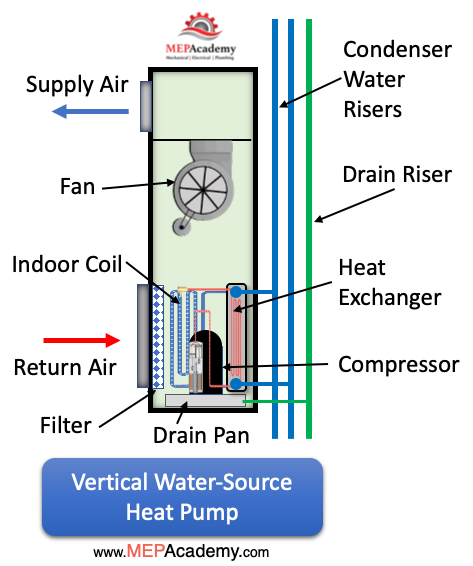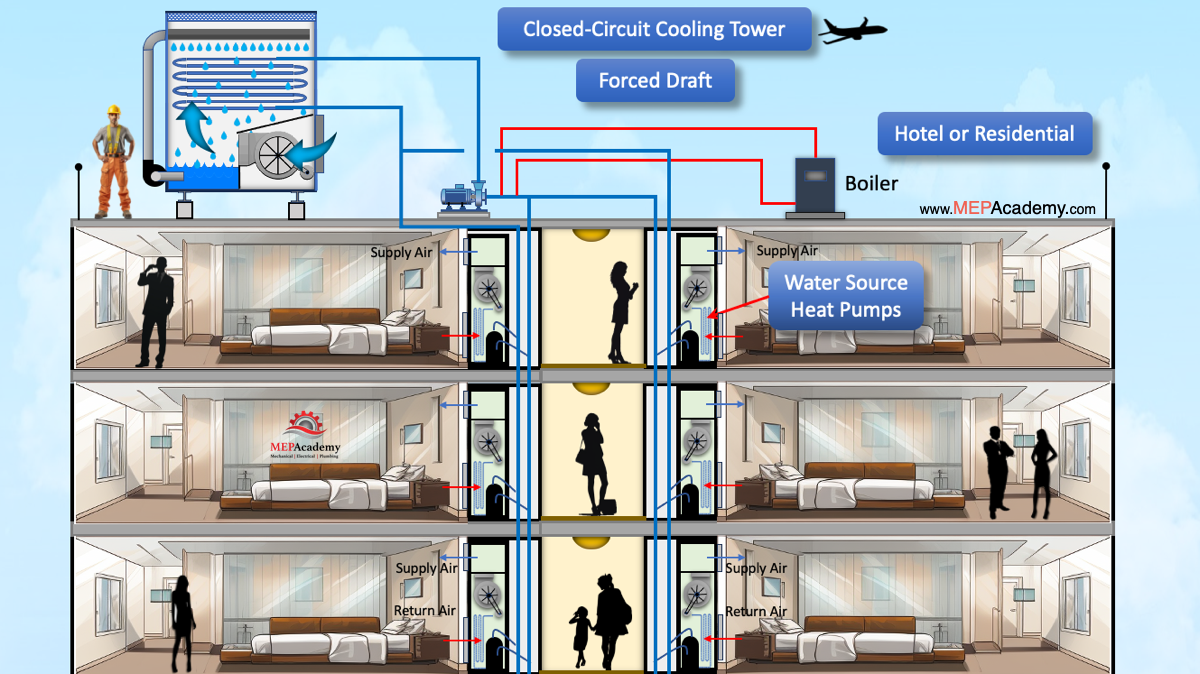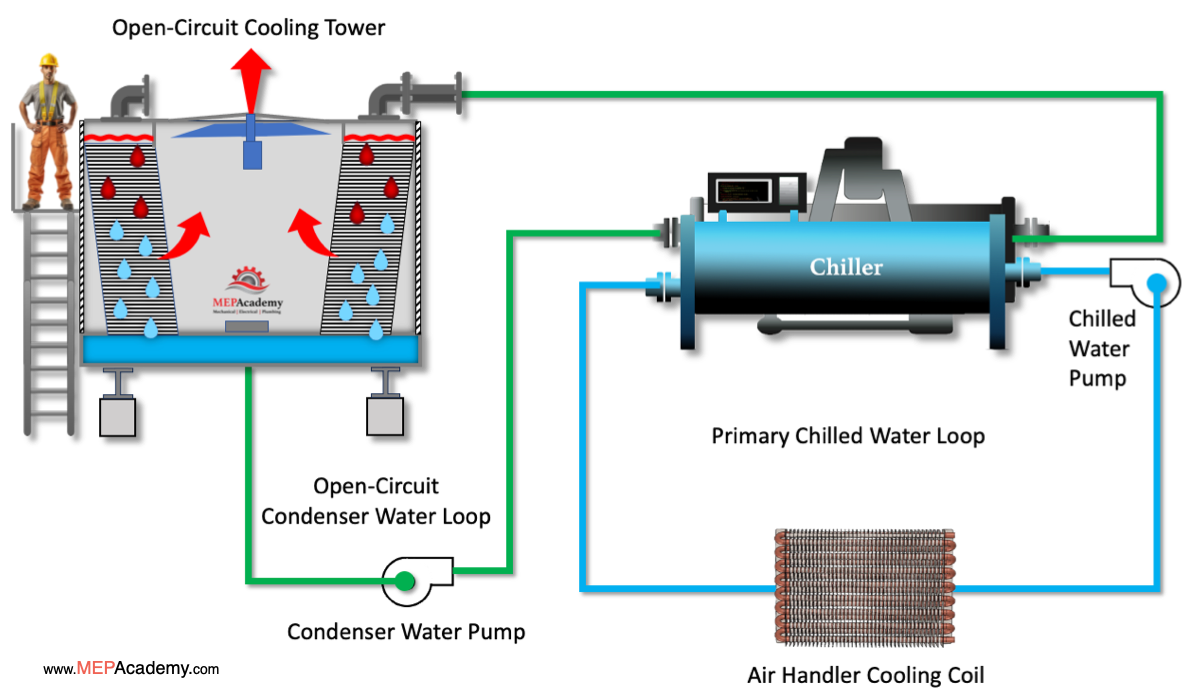In this article we’ll explain the differences between a Closed-Circuit and an Open-Circuit Cooling Tower and the advantages and disadvantage of each. How do you know which type to use for a project? They both provide heat rejection but in slightly different ways. These systems are often referred to as open and closed loop systems. These are the two commonly used HVAC cooling tower system designs.
If you prefer to watch the video of this presentation than scroll to the bottom.

Closed-Loop vs Open-Loop Operation
In a closed-circuit cooling tower, the process fluid, which could be water, or a water-glycol mixture is circulated within a closed loop piping system. There are two separate water sources, one external within a closed loop, and the second one that circulates water from the tower basin over the heat exchanger. There is never any contact between the water in the enclosed loop and the water circulated within the tower.
The water in the tower basin is pumped up and sprayed over the coil that is fed from the closed-loop piping while a fan forces air over the wet coil. This increases heat transfer through the coil while minimizing the evaporation of water from the basin. The cooled water in the closed-loop coil returns to the building to absorb more heat.

Return air brings heat from the space over the indoor coil. The refrigerant cycle moves that heat to the water-cooled condenser coil, where the water circulated from the cooling tower picks up that heat. The heat is pumped to the cooling towers closed-loop heat exchanger coil where water is sprayed over it as air is induced or forced over the coil.

Open-Circuit Cooling Tower
In an open circuit cooling tower, the water is directly exposed to the outside air. Water enters the top of the tower and is sprayed over the fill or heat transfer media. The exchange of heat occurs directly between the water and the entering ambient air. The water that is circulated to the chiller’s condenser and the air within the tower touch each other. This increases the chance of contaminants being scrubbed out of the air and into the cooling tower basin.

The water in the basin is then returned to the facility or the condenser side of a water-cooled chiller, which could foul the chillers condenser coil if the water is not properly treated. The makeup water to the tower can also introduce contaminants to the process water.
Induced-Draft vs Forced Draft
There are several tower configurations including induced draft and forced draft. The fans for an Induced draft tower are located at the top of the tower and induces air into the tower. The fans for a forced-draft tower are located at the bottom of the tower and forces air into the tower and over the coil.

Closed Circuit Cooling Tower Advantages and Disadvantages
Closed circuit cooling towers also known as Evaporative Fluid Coolers play a crucial role in the operation of water source heat pump systems in the HVAC industry. It’s important to use a closed loop system because the water is circulated into the coils of all the water-source heat pumps scattered throughout the building. Sending water from an open tower into all these remote coils could create a maintenance nightmare along with a reduction in efficiency for these units.

Advantages of a Closed-Circuit Cooling Tower
- Reduced risk of contamination since the process fluid is isolated from external elements.
- Water conservation as the process fluid is recirculated within a closed loop.
- Less susceptibility to scaling and fouling due to the closed nature of the system.
- Reduced equipment maintenance.
- Reduced water treatment cost due to lower volume of water circulated from the basin.
- Sensible heat rejection with pumps off, saving additional energy when conditions are right.
Disadvantages of a Closed-Circuit Cooling Tower
- Typically, higher initial cost due to the need for additional equipment like pumps and heat exchangers.
- Requires maintenance of the closed loop system to prevent corrosion and ensure fluid quality.
Applications
Closed circuit cooling towers are often preferred in applications where water quality is critical, and there’s a need to minimize the risk of contamination. This makes them suitable for water-cooled heat pump applications and those industries with strict quality standards, such as laboratories or data centers.
Open Circuit Cooling Tower Advantages and Disadvantages
Advantages of an Open-Circuit Cooling Tower
- Generally lower initial cost as there is no need for additional closed loop equipment.
- Simplicity in design and operation.
- Large range of capacities and configurations.
- Energy efficiency.
Disadvantages of an Open-Circuit Cooling Tower
- Greater susceptibility to contamination from external elements like dust, debris, and biological growth.
- More water consumption as water is continuously replenished and not recirculated.
- The requirement for water treatment.
- Extra level of maintenance.
- Reduced efficiency due to the scale and/or fouling of the Chillers Condenser coils if water treatment is not properly maintained.
- Complicated design when tower is installed below the piping system or pump.
Applications
Open circuit cooling towers are commonly used in the HVAC industry where water quality is less critical, and the focus is on cost-effective cooling. They are found in all types of buildings spanning the HVAC industry. The addition of a heat exchanger between the cooling tower and the chiller can add a layer of protection against the fouling of the chiller’s condenser tubes, but at an added cost. This doesn’t eliminate the need for water treatment of the tower, it just shifts the tower basin water from contacting the chillers coil to the heat exchanger.







